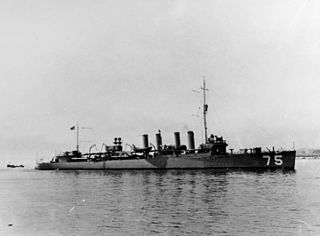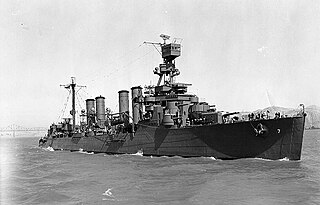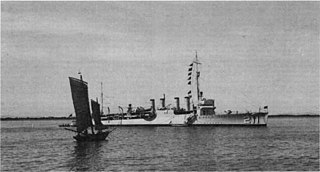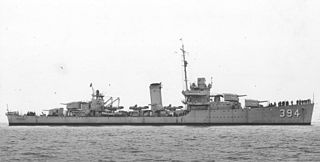
USS New Orleans was a United States Navy protected cruiser of the New Orleans class.

The third USS Charleston (C-22/CA-19) was a United States Navy St. Louis-class protected cruiser. She was launched 23 January 1904 by Newport News Shipbuilding and Dry Dock Co., Newport News, Virginia, sponsored by Miss Helen Whaley Rhett, and commissioned on 17 October 1905, Captain Cameron McRae Winslow in command. She was reclassified CA-19 on 17 July 1920.

USS New York (ACR-2/CA-2) was the second United States Navy armored cruiser so designated; the first was the ill-fated Maine, which was soon redesignated a second-class battleship. Due to the unusually protracted construction of Maine, New York was actually the first armored cruiser to enter U.S. Navy service. The fourth Navy ship to be named in honor of the state of New York, she was later renamed Saratoga and then Rochester. With six 8-inch guns, she was the most heavily armed cruiser in the US Navy when commissioned.

The first USS Wickes (DD-75) was the lead ship of her class of destroyers in the United States Navy during World War I, later transferred to the Royal Navy as HMS Montgomery. She has been the only ship of the Royal Navy to bear the name Montgomery.

USS Chattanooga (C-16/PG-30/CL-18) was a Denver-class protected cruiser in the United States Navy during World War I. She was the second Navy ship named for the city of Chattanooga, Tennessee.

USS Tacoma (C-18/PG-32/CL-20) was a Denver-class protected cruiser in the United States Navy during World War I. She was the second Navy ship named after the city of Tacoma, Washington.

USS Trenton (CL-11) was an Omaha-class light cruiser, originally classified as a scout cruiser, of the United States Navy. She was the second Navy ship named for the city of Trenton, New Jersey. She spent most of her pre-war career moving between the Atlantic and the Pacific. Trenton joined the Special Service Squadron in 1934, for a good-will tour of Latin America. In May 1939, she would join Squadron 40-T in protecting American interests during the Spanish Civil War and not return to the US until July 1940, when she carried the royal family of Luxembourg, fleeing from the Nazi occupation of their country.

USS Raleigh (CL-7) was the fourth Omaha-class light cruiser, originally classified as a scout cruiser, built for the United States Navy. She was the third Navy ship named for the city of Raleigh, North Carolina. The first being Raleigh, a 32–gun frigate built in 1776, during the American Revolution, and captured by the British in 1778. The second was the protected cruiser Raleigh, commissioned in 1894, and decommissioned in 1919.

The second USS Marblehead (C-11/PG-27) was a Montgomery-class unprotected cruiser in the United States Navy, authorized in the naval appropriations bill of September 7, 1888. Marblehead served in the Spanish–American War and World War I, and was the last ship of her class in service.

USS Alden (DD-211) was a Clemson-class destroyer of the United States Navy (USN). Serving during World War II, Alden is the only ship of the US Navy to have been named for Rear Admiral James Alden, Jr. (1810–1877).

USS Simpson (DD-221/APD-27/AG-97) was a Clemson-class destroyer in the United States Navy during World War II. She was the first ship named for Rear Admiral Edward Simpson.

USS Truxtun (DD-229) was a Clemson-class destroyer in the United States Navy during World War II. She was the third ship named for Thomas Truxtun.

USS Fox (DD-234/AG-85) was a Clemson-class destroyer in the United States Navy during World War II. She was the fourth ship named for Gustavus Vasa Fox, Assistant Secretary of the Navy during the Civil War.

The second USS McDougal (DD-358/AG-126) was a Porter-class destroyer in the United States Navy. She named for Rear Admiral David Stockton McDougal.

USS Warrington (DD-383) was a Somers-class destroyer, laid down on 10 October 1935 at Kearny, New Jersey, by the Federal Shipbuilding and Drydock Company; launched on 15 May 1937; sponsored by Miss Katherine Taft Chubb; and commissioned at the New York Navy Yard on 9 February 1938.

The second USS Sampson (DD-394) was a Somers-class destroyer in the United States Navy. She was named of William Thomas Sampson a rear admiral known for his victory in the Battle of Santiago de Cuba during the Spanish–American War.

USS Stewart (DE–238) is an Edsall-class destroyer escort, the third United States Navy ship so named. This ship was named for Rear Admiral Charles Stewart, who commanded USS Constitution during the War of 1812. Stewart is one of only two preserved destroyer escorts in the U.S. and is the only Edsall-class vessel to be preserved. She is on display in Galveston, Texas as a museum ship and is open to the public.
USS Charleston (PG-51), the fourth vessel to carry her name, was the second of two Erie-class patrol gunboats. Launched from the Charleston Navy Yard on 25 February 1936, and commissioned on 8 July 1936 and was part of the Atlantic Fleet.

USS Enoree (AO-69) was a Chiwawa-class oiler constructed for the United States Navy during World War II. She was the only U.S. Navy ship named for the Enoree River in South Carolina.



















